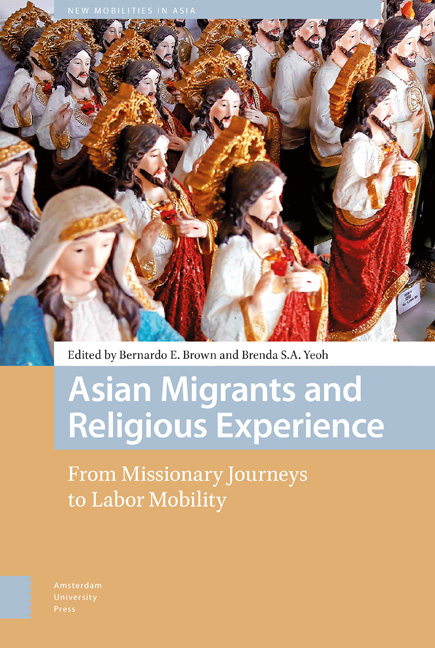Book contents
- Frontmatter
- Contents
- List of Illustrations
- Acknowledgments
- 1 Introduction: Human Mobility as Engine of Religious Change
- Section 1 Mobile Religious Practices
- 2 Saving Yogis: Spiritual Nationalism and the Proselytizing Missions of Global Yoga
- 3 Renewed Flows of Ritual Knowledge and Ritual Affect within Transnational Networks: A Case Study of Three Ritual Events of the Xinghua (Henghua) Communities in Singapore
- 4 Liberalizing the Boundaries: Reconfiguration of Religious Beliefs and Practice amongst Sri Lankan Immigrants in Australia
- Section 2 Transnational Proselytizing
- 5 From Structural Separation to Religious Incorporation: A Case Study of a Transnational Buddhist Group in Shanghai, China
- 6 “10/40 Window”: Naga Missionaries as Spiritual Migrants and the Asian Experience
- 7 Religion, Masculinity, and Transnational Mobility: Migrant Catholic Men and the Politics of Evangelization
- 8 Helping the Wounded as Religious Experience: The Free Burma Rangers in Karen State, Myanmar
- Section 3 Refashioning Religiosity in the Diaspora
- 9 A Multicultural Church: Notes on Sri Lankan Transnational Workers and the Migrant Chaplaincy in Italy
- 10 “Bahala Na Ang Diyos”: The Paradox of Empowerment among Filipino Catholic Migrants in South Korea
- 11 Feeling Hindu: The Devotional Sivaist Esthetic Matrix and the Creation of a Diasporic Hinduism in North Sumatra
- 12 Afterword: What Makes Asian Migrants’ Religious Experience Asian?
- References
- Index
1 - Introduction: Human Mobility as Engine of Religious Change
Published online by Cambridge University Press: 12 December 2020
- Frontmatter
- Contents
- List of Illustrations
- Acknowledgments
- 1 Introduction: Human Mobility as Engine of Religious Change
- Section 1 Mobile Religious Practices
- 2 Saving Yogis: Spiritual Nationalism and the Proselytizing Missions of Global Yoga
- 3 Renewed Flows of Ritual Knowledge and Ritual Affect within Transnational Networks: A Case Study of Three Ritual Events of the Xinghua (Henghua) Communities in Singapore
- 4 Liberalizing the Boundaries: Reconfiguration of Religious Beliefs and Practice amongst Sri Lankan Immigrants in Australia
- Section 2 Transnational Proselytizing
- 5 From Structural Separation to Religious Incorporation: A Case Study of a Transnational Buddhist Group in Shanghai, China
- 6 “10/40 Window”: Naga Missionaries as Spiritual Migrants and the Asian Experience
- 7 Religion, Masculinity, and Transnational Mobility: Migrant Catholic Men and the Politics of Evangelization
- 8 Helping the Wounded as Religious Experience: The Free Burma Rangers in Karen State, Myanmar
- Section 3 Refashioning Religiosity in the Diaspora
- 9 A Multicultural Church: Notes on Sri Lankan Transnational Workers and the Migrant Chaplaincy in Italy
- 10 “Bahala Na Ang Diyos”: The Paradox of Empowerment among Filipino Catholic Migrants in South Korea
- 11 Feeling Hindu: The Devotional Sivaist Esthetic Matrix and the Creation of a Diasporic Hinduism in North Sumatra
- 12 Afterword: What Makes Asian Migrants’ Religious Experience Asian?
- References
- Index
Summary
There is a fundamental obstacle that makes the combined study of religion and migration particularly difficult: while migration is perceived as the realm of the mobile and transient, religion is imagined as the province of the spatially fixed and historically enduring. Contemporary efforts to bring both areas of research together within a common field are not rare, yet they tend to privilege the disciplinary background of the authors, relegating either religion or migration to a complementary status from their main focus of research. For example, when scholars of religion engage with migration and transnationalism, mobile religious practices appear as an epiphenomenon of global conditions that give rise to unique dynamics which are worthy of study, but not of intrinsic importance to understand religion itself. Robert Orsi's seminal work in The Madonna of 115th Street (1985) is a preeminent illustration of how scholars of religion have explored migrant religiosity as a space of identity formation and reconnection to the homeland, but where migration only sets the stage for a particular spatiotemporal approach to the study of religious practices amongst migrant communities.
From the opposite perspective, scholars of migration and transnationalism recognize the importance of religion in the lives of migrants as a means to give a community visibility in the host society (Baumann 2009; Sinha 2006), to provide safety nets and networks of employment and solidarity (Hagan 2008; Bautista 2016), and to sustain membership in multiple locations (Levitt & Glick-Schiller 2004). To take one example, Peggy Levitt's work in The Transnational Villagers (2001) accords migrant religion generous treatment, yet the approach remains firmly situated in the field of transnational studies, only marginally engaging with scholars whose research is rooted within a religious studies perspective.
Despite the different aspects of religion in migration that these influential research projects emphasize, there are two premises that they share. Firstly, migrants are seen as having a religious identity that they bring with them to their place of settlement and that they use in different ways to reinforce attachments or highlight boundaries; meanwhile, the ethical and theological underpinnings of religious affiliation itself are never seriously brought into question. Religious attachments thus are thought to remain firmly rooted in the country of origin and the desire of migrant communities to maintain them as intact as possible is usually taken for granted.
- Type
- Chapter
- Information
- Asian Migrants and Religious ExperienceFrom Missionary Journeys to Labor Mobility, pp. 11 - 32Publisher: Amsterdam University PressPrint publication year: 2018

